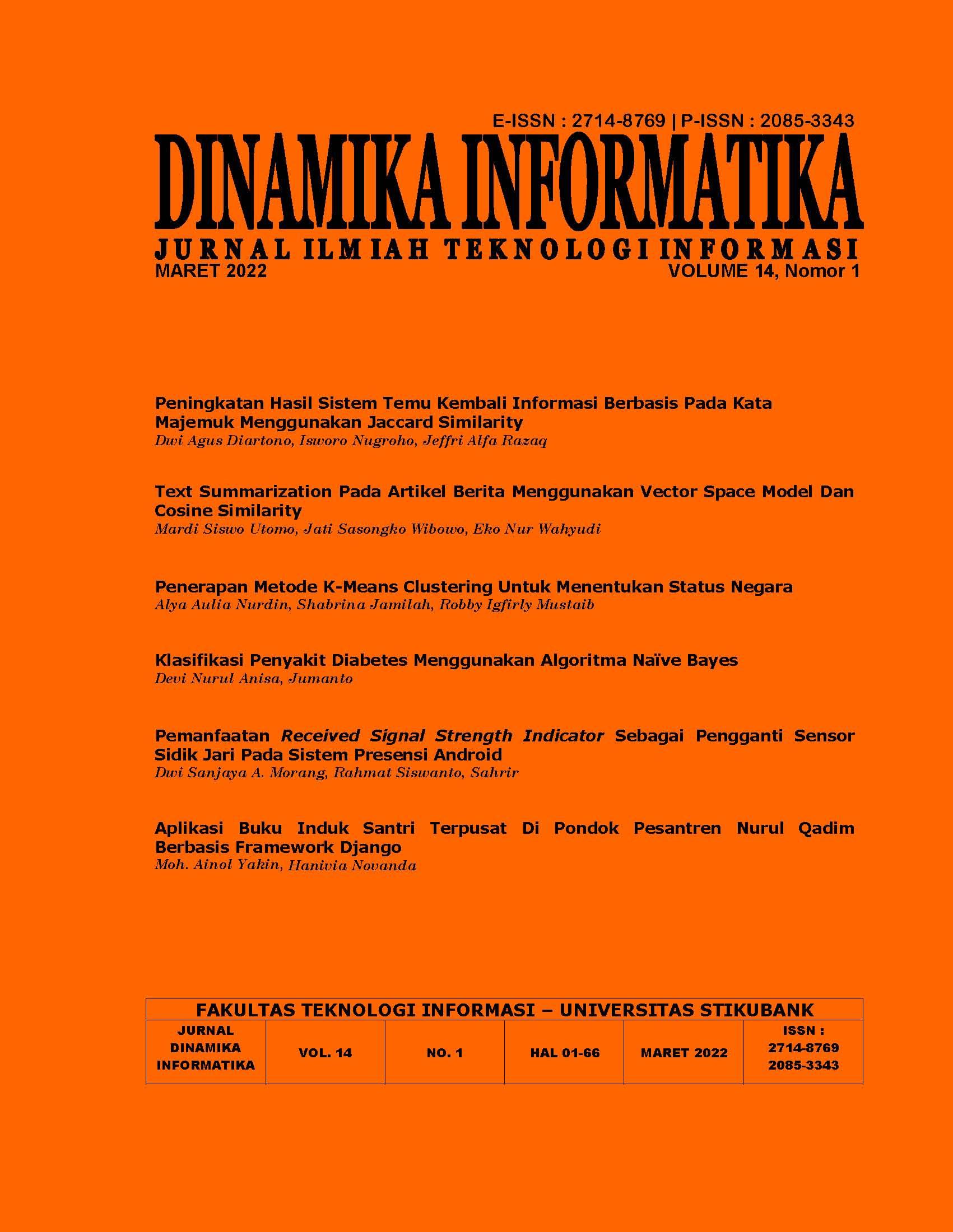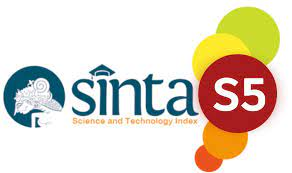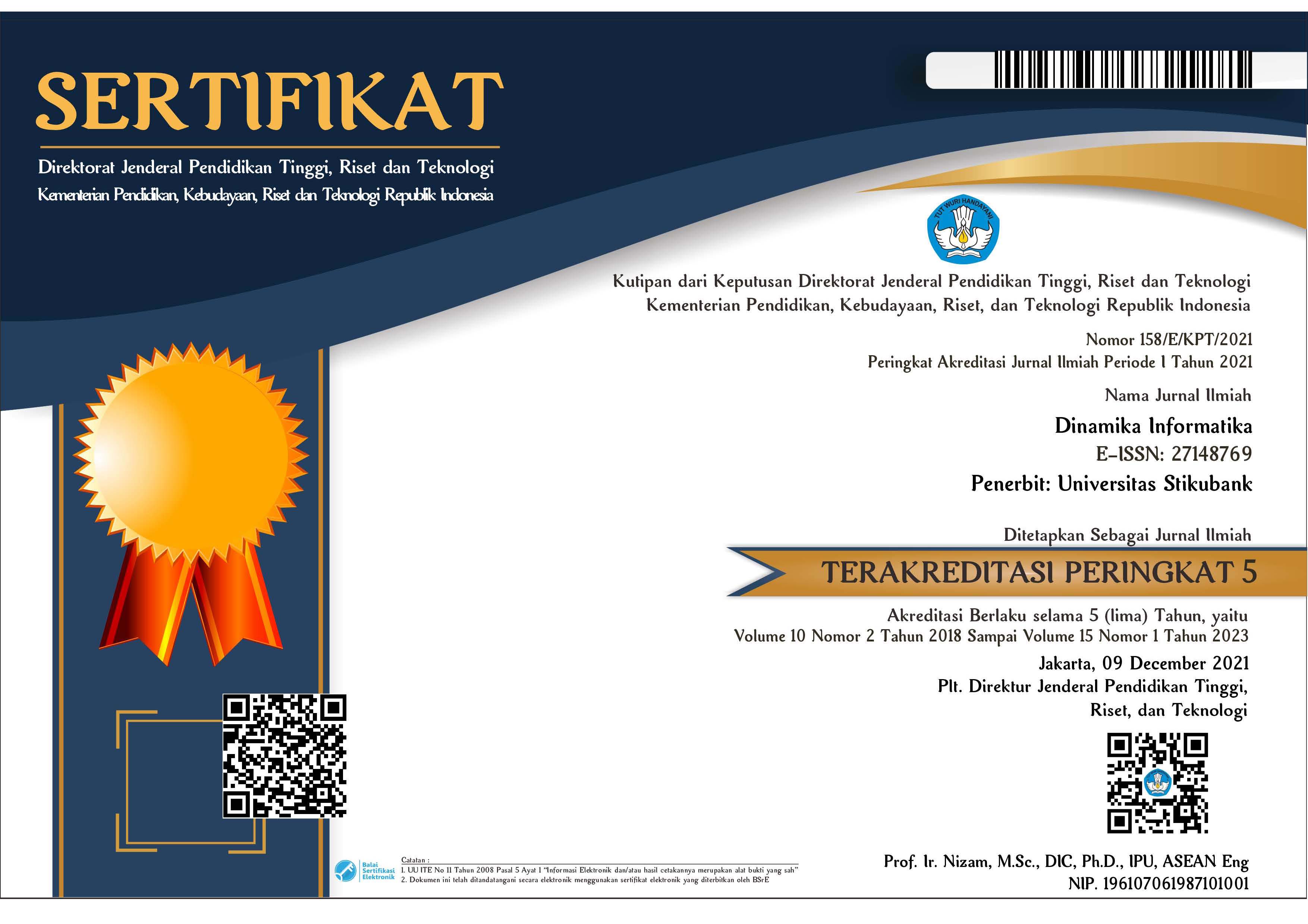PENERAPAN METODE K-MEANS CLUSTERING UNTUK MENENTUKAN STATUS NEGARA
Abstract
Status dari sebuah negara merupakan hal yang penting untuk diketahui. Hal tersebut dikarenakan status negara dapat menunjang kesuksesan suatu investasi, bisnis, dan juga pemerataan pembangunan oleh pemerintahnya. Status negara yang sering didengar oleh masyarakat, yakni negara maju dan negara berkembang. Dalam studi kasus penentuan status negara ini, penulis mengambil dataset International Monetary Fund (IMF) yang diperoleh dari situs github. Kemudian data mentah dilakukan preproccessing terlebih dahulu berupa impute values dan normalisasi, lalu selanjutnya dilakukan perhitungan klastering dengan metode K-Means. Data akan dibagi menjadi empat klaster dan perhitungan dilakukan dengan dua cara, yakni melalui Microsoft Excel dan Rapid Miner. Berdasarkan perhitungan yang telah dilakukan, 186 negara sudah terbagi menjadi empat klaster yakni, klaster negara agraris, negara industri, negara berkembang, dan negara maju. Penentuan klasterisasi status negara tersebut cukup dikatakan valid karena performance vectornya sebesar 70%.
References
[2] M. Wielechowski, D. Cherevyk, K. Czech, P. Kotyza, Ł. Grzęda, and L. Smutka, “Interdependence between human capital determinants and economic development: K-means regional clustering approach for Czechia and Poland,” Entrep. Bus. Econ. Rev., vol. 9, no. 4, pp. 173–194, 2021, doi: 10.15678/EBER.2021.090411.
[3] S. Basel, K. U. Gopakumar, and R. P. Rao, “Classification of countries based on development indices by using K-means and grey relational analysis,” GeoJournal, vol. 2, no. 2011, 2021, doi: 10.1007/s10708-021-10479-2.
[4] U. A. Gani, R. Bambang, and K. Umam, “Discriminant Analysis of Classify Developed Countries and Developing Countries With Fisher Method,” J. Geuthèë Penelit. Multidisiplin, vol. 01, no. 01, pp. 1–12, 2018, [Online]. Available: http://www.journal.geutheeinstitute.com.
[5] A. A. Nurdin, “Decision support system for choosing the best tourist attractions using simple additive weighting (SAW) method,” J. Soft Comput. Explor., vol. 2, no. 2, pp. 77–85, 2021.
[6] D. Barbe and L. Pennington-Gray, “Social Media and Crisis Communication in Tourism and Hospitality,” Handb. e-Tourism, pp. 1–27, 2020, doi: 10.1007/978-3-030-05324-6_130-1.
[7] Y. Prayoga, H. S. Tambunan, and I. Parlina, “Penerapan Clustering Pada Laju Inflasi Kota Di Indonesia Dengan Algoritma K-Means,” BRAHMANA J. Penerapan Kecerdasan Buatan, vol. 1, no. 1, pp. 24–30, 2019, doi: 10.30645/brahmana.v1i1.4.
[8] N. Hazimah, S. Harahap, A. Amirullah, M. B. Saputro, and I. A. Tamaroh, “Classification of potential customers using C4 . 5 and k-means algorithms to determine customer service priorities to maintain loyalty,” pp. 123–130, 2022, doi: 10.52465/joscex.v3i2.89.
[9] R. W. Sari and D. Hartama, “Data Mining : Algoritma K-Means Pada Pengelompokkan Wisata Asing ke Indonesia Menurut Provinsi,” Semin. Nas. Sains Teknol. Inf., pp. 322–326, 2018.
[10] A. Kijewska and A. Bluszcz, “Research of varying levels of greenhouse gas emissions in European countries using the k-means method,” Atmos. Pollut. Res., vol. 7, no. 5, pp. 935–944, 2016, doi: 10.1016/j.apr.2016.05.010.
[11] A. P. Windarto, “Implementation of Data Mining on Rice Imports by Major Country of Origin Using Algorithm Using K-Means Clustering Method,” Int. J. Artif. Intell. Res., vol. 1, no. 2, p. 26, 2017, doi: 10.29099/ijair.v1i2.17.
[12] N. A. Febriyati, A. D. GS, and A. Wanto, “GRDP Growth Rate Clustering in Surabaya City uses the K-Means Algorithm,” IJISTECH (International J. Inf. Syst. Technol., vol. 3, no. 36, pp. 276–283, 2020.
[13] A. B. M. Bintang, “Pengaruh PDRB, Pendidikan, Kesehatan, dan Pengangguran Terhadap Tingkat Kemiskinan di Jawa Tengah (2011-2015),” MEDIA Ekon. DAN Manaj., vol. 33, no. 1, pp. 20–28, 2018.
[14] R. Giovanni, “Analisis Pengaruh PDRB, Pengangguran dan Pendidikan Terhadap Tingkat Kemiskinan di Pulau Jawa Tahun 2009-2016,” Econ. Dev. Anal. J., vol. 7, no. 1, pp. 23–31, 2018.
[15] S. Rustam, “Analisa Clustering Phising Dengan K-Means Dalam Meningkatkan Keamanan Komputer,” Ilk. J. Ilm., vol. 10, no. 2, pp. 175–181, 2018, doi: 10.33096/ilkom.v10i2.309.175-181.
[16] A. Kigerl, “Cyber crime nation typologies: K-means clustering of countries based on cyber crime rates,” Int. J. Cyber Criminol., vol. 10, no. 2, pp. 147–169, 2016, doi: 10.5281/zenodo.163399.
[17] R. W. Sari, A. Wanto, and A. P. Windarto, “Implementasi Rapidminer Dengan Metode K-Means (Study Kasus: Imunisasi Campak Pada Balita Berdasarkan Provinsi),” KOMIK (Konferensi Nas. Teknol. Inf. dan Komputer), vol. 2, no. 1, pp. 224–230, 2018, doi: 10.30865/komik.v2i1.930.
[18] N. Rofiqo, A. P. Windarto, and D. Hartama, “Penerapan Clustering Pada Penduduk Yang Mempunyai Keluhan Kesehatan Dengan Datamining K-Means,” KOMIK (Konferensi Nas. Teknol. Inf. dan Komputer), vol. 2, no. 1, pp. 216–223, 2018, doi: 10.30865/komik.v2i1.929.
[19] V. Chandu, “Identification of spatial variations in COVID-19 epidemiological data using K-Means clustering algorithm: a global perspective,” medRxiv, p. 2020.06.03.20121194, 2020, [Online]. Available: http://medrxiv.org/content/early/2020/06/05/2020.06.03.20121194.abstract.
[20] J. Hutagalung, N. L. W. S. R. Ginantra, G. W. Bhawika, W. G. S. Parwita, A. Wanto, and P. D. Panjaitan, “COVID-19 Cases and Deaths in Southeast Asia Clustering using K-Means Algorithm,” J. Phys. Conf. Ser., vol. 1783, no. 1, 2021, doi: 10.1088/1742-6596/1783/1/012027.
[21] M. E. Al Rivan and R. A. Sonaru, “Perbandingan Metode K-Means Dan GA K-Means Untuk Clustering Dataset Heart Disease Patients,” J. Tek. Inform. dan Sist. Inf., vol. 9, no. 3, pp. 2585–2597, 2022.
[22] Z. Karaca, “the Cluster Analysis in the Manufacturing Industry With K-Means Method: an Application for Turkey,” Eurasian J. Econ. Financ., vol. 6, no. 3, pp. 1–12, 2018, doi: 10.15604/ejef.2018.06.03.001.
[23] A. Jha and D. Saha, “Examining categorization of Telecom Circles in India using unsupervised k-means clustering on techno-economic indicators,” Decision, vol. 46, no. 4, pp. 365–383, 2019, doi: 10.1007/s40622-019-00225-6.
[24] A. M. and T. Georgiadis, “Economic clustering of countries in the Asia-Pacific region,” Eletronic Libr., vol. 34, no. 1, pp. 1–5, 2004.
[25] A. A. Nurdin and D. Djuniadi, “Securing audio chat with cryptool-based twofish algorithm,” J. Soft Comput. Explor., pp. 37–43, 2022, doi: 10.52465/joscex.v3i1.65.
Copyright (c) 2022 Alya Aulia Nurdin

This work is licensed under a Creative Commons Attribution 4.0 International License.













